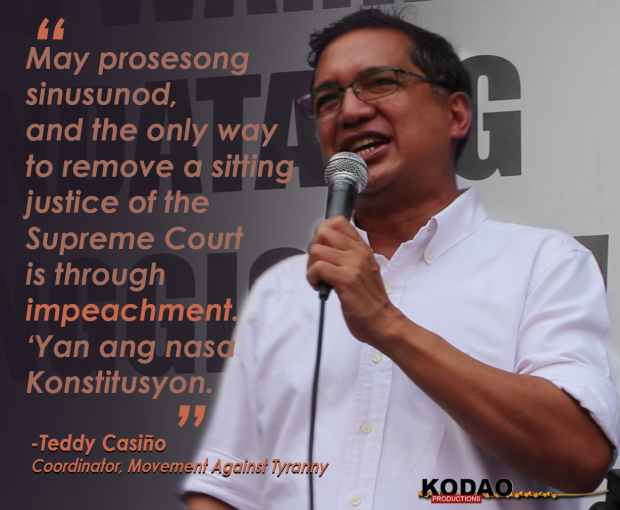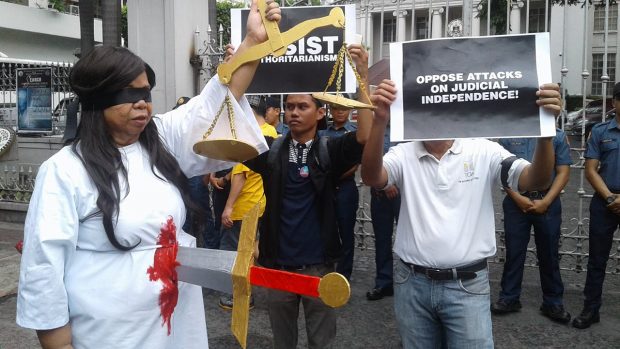It’s not just about Sereno
By Luis V. Teodoro
The unprecedented removal through quo warranto proceedings of Chief Justice Ma. Lourdes Sereno from her post isn’t only about her, or solely about the Supreme Court, the rule of law, the Constitution, or the Duterte regime and its autocratic pretensions. Even more crucially is it about the fate and future of the democratization process that at least twice in history has been interrupted at its most crucial stage, and, driven by the need to address political and economic underdevelopment, has had to twice start all over again in this country.
The democratization of Philippine society began with the reform movement of the late 19th century and reached its highest point during the Revolution of 1896, which was as much for independence, equality and social justice as it was against Spanish colonial rule. Through the worker-led Katipunan, the Revolution was on the verge of defeating the Spanish forces and had achieved de facto independence when a near-fatal combination of betrayal by the Magdalo faction of the rural gentry and foreign intervention prevented its fruition despite the First Republic, and left it unfinished.
United States recognition of Philippine independence in 1946 made the resumption of the democratization process and the completion of the Revolution possible. But thanks to the heirs of the principalia — the handful of families the US had trained in the fine arts of backroom politics and self-aggrandizement during its formal occupation of the Philippines — what instead ensued for two decades was a succession of administrations that prospered while presiding over the country and its people’s continuing poverty and underdevelopment, subservience to foreign interests, and political disempowerment.
Against these fundamental ills there had always been both armed and unarmed resistance even during the country’s captivity to US colonialism. But it was in the mid-1960s when the historic demands of the Philippine Revolution found their best expression in the movement for change initially led by workers and students which soon spread across the entire country and among various sectors. Its demand for the democratization of political power, for authentic independence, gender equality, agrarian revolution, and national industrialization resonated enough among the peasantry, progressive professionals, indigenous peoples, the enlightened religious, and liberated women to mobilize hundreds of thousands.
In the First Quarter Storm of 1970, the numbers of its adherents and the power of their demands were demonstrably enough for the second Marcos administration to use state violence to suppress the strikes, demonstrations and other mass actions that were almost daily challenging dynastic rule by demanding the end of feudalism, bureaucrat capitalism and imperialism. In response to these demands, and to keep himself in power beyond 1973, Marcos suspended the privilege of the writ of habeas corpus in 1971 and made good on his threat to declare martial law in 1972, when he placed the entire country under a dictatorship sustained by military bayonets on the pretext of saving the Republic and reforming society while actually doing the opposite.
Despite the worst repression, despite the arrests and detention, despite the torture, enforced disappearances and extrajudicial killing of thousands of the best and brightest sons and daughters of the people, it was in the resistance to the Marcos terror regime that democratization continued to find expression.
Many of those in the resistance refused to surrender it during the period of repression, but it took 14 years of armed and unarmed defiance before the Filipino people once more recovered the possibility of exercising the democratic right to shape their own future. However, despite its promise of far-reaching change with the overthrow of the Marcos dictatorship, over the last 32 years the 1986 civilian-military mutiny known as People Power or EDSA 1 has failed to deliver on that promise, thanks to the continuing monopoly over political power of the same dynasties that for over a century have prevented the realization of the changes Philippine society so desperately needs.
Over those three decades, people’s organizations and other democratic formations persisted in fighting for those changes. In 2001, outraged over the corruption and incompetence of a plunderous regime, they removed another president from power. While state repression in various forms, and with it such human rights violations as torture, enforced disappearances, abductions and extrajudicial killings continued, the reigns of three of the five presidents after Marcos that preceded Rodrigo Duterte’s have not been openly antagonistic to due process, the bill of rights, press freedom, and the system of checks and balances.
The Corazon Aquino, Fidel Ramos, and Benigno Aquino III administrations at least paid lip service to the desirability of peace and the rule of law. But one cannot say the same of the Joseph Estrada and Gloria Macapagal-Arroyo regimes. The former was mostly focused on the use of the presidency in amassing wealth, while the latter was intent on remaining in power, and did not hesitate to use state violence to suppress dissent and opposition in advancing and protecting the personal, family and class interests behind it.
But it is the Duterte regime, with the enthusiastic support of the Estrada and Arroyo cliques, that has most imperiled the realization of the legitimate demands for the democratization of political power and economic opportunity, true independence, and inclusive development. It has become increasingly clear that President Rodrigo Duterte has not bothered to craft any master plan to end or even reduce poverty, or even such of its manifestations as environmental degradation, limited employment opportunities and low agricultural productivity under an archaic tenancy system. But he does have a blueprint for the restoration of authoritarian rule through his accomplices’ and minions’ dominance in the executive, legislative and judicial branches of government.
The abridgment of press freedom, the attacks on human rights, the willful debasement of public discourse, the further erosion of the already erratic observance of the rule of law, and the subversion of the little that survives of the system of checks and balances through the orchestrated attacks on the ombudsman and Chief Justice Sereno are parts of the plot to undermine what little is left of democracy in these isles of uncertainty. By riding the crest of mass disaffection with government and the burgeoning demand for change and revolution to win the Presidency in 2016, Mr. Duterte has managed to hijack all three branches of government.
The ouster of Sereno as Chief Justice is not solely about Sereno. Neither is it about the Maleficent Six. It is about the imminent danger of dictatorship. This is the context in which, with the collaboration of his cohorts in Congress and the Supreme Court itself, Mr. Duterte is putting a stop to the democratization of Philippine society as Ferdinand Marcos did in 1972. For the third time since the late 19th and early 20th centuries, that process is once more in danger of interruption — and worse, its final liquidation.
In these circumstances only the people themselves can put a stop to the latest assault on their right to self-government and the realization of their aspirations for a society of peace, justice and equality. Because the leaders to whom they had previously delegated their sovereign authority had failed them, they exercised their right and duty to remove them in 1986, and again in 2001.
Some events in the political lives of nations can be the turning point in the resolution of the contradictions that afflict them. The Sereno “incident” could be that point.
(First published in BusinessWorld. Photo from the Supreme Court.)


